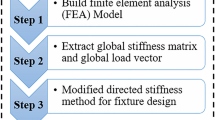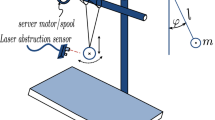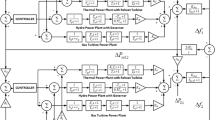Abstract
This paper considers a dual-rate distributed predictive control strategy for the looper tension system in hot rolling mills, which is a typical multi-agent system with directed communication topology. First, we establish an interconnected model for looper tension control system and the disturbances from the neighbors are considered effectively. Second, the consensus control protocol is developed based on the proposed control strategy to improve the robustness and stability of the multi-agent, and the sufficient conditions for consensus are developed. We update and implement all the agent controllers sequentially in one output sampling period and begin a new cycle at the next sampling instant, which leads the multi-agent control system is of fast control updating rate and slow output sampling rate. The control inputs of neighbors can be obtained to compensate the coupling effects, and the cooperation of controllers are improved. Finally, simulation results verify the proposed control strategy and corresponding results.
Similar content being viewed by others
References
X. Yu and L. Liu, “Distributed circular formation control of ring-networked nonholonomic vehicles,” Automatica, vol. 68, pp. 92–99, February 2016. [click]
C. Wang and C. J. Ong, “Distributed model predictive control of dynamically decoupled systems with coupled cost,” Automatica, vol. 46, no. 5, pp. 2053–2058, October 2010. [click]
H.-P. Li, Y. Shi, and W.-S. Yan, “Distributed receding horizon control of constrained nonlinear vehicle formations with guaranteed g -gain stability,” Automatica, vol. 68, pp. 148–154, February 2016. [click]
H. T. Zhang, C. Zhai, and Z. Y. Chen, “A general alignment repulsion algorithm for flocking of multi-agent systems,” IEEE Transactions on Automatic Control, vol. 56, no. 2 pp. 430–435, February 2011. [click]
C.-R Wang and H.-B. Ji, “Leader-following consensus of multi-agent systems under directed communication topology via distributed adaptive nonlinear protocol,” Systems & Control Letters, vol. 70, pp. 23–29, June 2014. [click]
J. L. Wang and H. N. Wu, “Leader-following formation control of multi agent systems under fixed and switching topologies,” Int. J. Control, vol. 85, no. 6 pp. 695–705, 2012. [click]
Y. Cao and W. Ren, “Multi-vehicle coordination for double integrator dynamics under fixed undirected/directed interaction in a sampled data setting,” International Journal of Robust and Nonlinear Control, vol. 20, pp. 987–999, 2010. [click]
L. Wang and F. Xiao, “Finite-time consensus problems for networks of dynamic agents,” IEEE Transactions on Automatic Control, vol. 55, no. 4 pp. 950–955, 2010. [click]
S. Li, H. Du, and X. Lin, “Finite-time consensus algorithm for multi-agent systems with double-integrator dynamics,” Automatica, vol. 47, pp. 1706–1712, 2011.[click]
J.-S. Huang, C.-Y. Wen, W. Wang, and Y.-D. Song, “Adaptive finite-time consensus control of a group of uncertain nonlinear mechanical systems,” Automatica, vol. 51, pp. 292–301, 2015. [click]
H. Zhang, F. Lewis, and A. Das, “Optimal design for synchronization of cooperative systems: state feedback, observer and output feedback,” IEEE Transactions on Automatic Control, vol. 56, no. 8, pp. 1948–1952, 2011. [click]
J.-T Li, Y. Wang, and H.-M. Xiao, “Consensus Seeking of Multi-agent Systems from an Iterative Learning Perspective,” International Journal of Control, Automation and Systems, vol. 14, no. 5, pp. 1173–1182, 2016. [click]
I. D. Couzin, J. Krause, R. James, G. D. Ruxton, and N. R. Franks, “Collective memory and spatial sorting in animal groups,” J. Theoretical Biol., vol. 218, pp. 1–11, 2012. [click]
P. D. Christofides, R. Scattolini, D.-M. Pena, and J.-F Liu, “Distributed model predictive control: A tutorial review and future research directions,” Computers and Chemical engineering, vol. 51, pp. 21–41, 2013. [click]
Z.-M. Cheng, H.-T Zhang, M.-C Fan, and G.-R. Chen, “Distributed consensus of multi-agent systems with input constraints: A model predictive control approach,” IEEE transactions on circuits and systems-1:regular papers, vol. 62, no. 3, pp. 825–834, 2015. [click]
G. Ferrari-Trecate, L. Galbusera, M. P. E. Marciandi, and R. Scattolini, “Model predictive control schemes for consensus in multi-agent systems with single- and doubleintegrator dynamics,” IEEE Trans.Autom. Control, vol. 54, no. 11, pp. 2560–2572, 2009. [click]
E. Camponogara and H. F. Scherer, “Distributed optimization for model predictive control of linear dynamic networks with control-input and output constraints,” IEEE Transactions on Automation Science and Engineering, vol. 8, no. 1, pp. 233–242, 2011. [click]
A. Richards and J. P. How, “Robust distributed model predictive control,” International Journal of Control, vol. 80, no.9, pp. 1517–1531, 2007. [click]
H.-T. Zhang, M. Z. Q. Chen, and G.-B. Stan, “Fast consensus via predictive pinning control, IEEE Trans,” Automatica, vol. 58, no. 9, pp. 2247–2258, 2011. [click]
Y. Yuan, G. B. Stan, L. Shi, M. Barahona, and J. Goncalves, “Decentralized minimum-time consensus,” Automatica, vol. 49, pp. 1227–1235, 2013. [click]
E. Camponogara and L. B. de Oliveira, “Distributed optimization for model predictive control of linear-dynamic networks,” IEEE Trans. Syst.,Man Cybern. A, vol. 39, no. 6, pp. 1331–1338, 2009. [click]
K.-V. Ling, W.-K. Ho, and B.-F. Wu, “Multiplexed MPC for multizone thermal processing in semiconductor manufacturing,” IEEE transactions on control system technology, vol. 18, no. 6, pp. 1371–1380, 2010. [click]
K.-V. Ling, W.-K. Ho, Y. Feng, and B.-F Wu, “Integralsquare- error performance of multiplexed model predictive control,” IEEE transactions on industrial informatics, vol. 7, no. 2, pp. 196–203, 2011. [click]
P. Wang and B. Ding, “Distributed RHC for tracking and formation of nonholonomic multi-vehicle systems,” IEEE transactions on automatic control, vol. 59, no. 6, pp. 1439–1453, 2014.[click]
H. M. Kristian and F. L. Lewis, “Cooperative optimal control for multi-agent systems on directed graph topologies,” IEEE Transactions on Automatic Control, vol. 59, no. 3, pp. 769–774, 2014. [click]
H. M. Kristian, F. L. Lewis, and S. Michael, “Distributed static output-feedback control for state synchronization in networks of identical LTI systems,” Automatica, vol. 53, pp. 282–290, 2015. [click]
H.-P. Li and W.-S. Yan, “Receding horizon control based on consensus scheme in general linear multi-agent systems,” Automatica, vol. 56, pp. 12–18, 2015. [click]
I. S. Choi, J. A. Rossiter, and P. J. Fleming, “Looper and tension control in hot rolling mills: A survey,” Journal of Process Control, vol. 17, pp. 509–521, 2007. [click]
S. Ye, “Decoupling control and simulation of looper MIMO system for hot strip rolling mill,” Advanced Materials Research, vol.846, pp. 360–364, 2014. [click]
H.-W. Wang, Y.-W. Jing, and C. Yu, “Guaranteed cost sliding mode control for looper-tension multivariable uncertain systems,” Nonlinear Dynamics, vol. 80, no. 1 pp. 39–50, 2015.
C.-N. Tong, Y.-K. Wu, L.-M. Liu, and J.-Y. Li, “Modeling and integral variable structure control of hydraulic looper multivariable system,” Acat Automatic Sinica, vol. 34, no. 10 pp. 1305–1311, 2008.
C. J. Park and I. C. Hwang, “Tension control in hot strip process using adaptive receding horizon control,” Journal of Materials Processing Technology, vol. 209, pp. 426–434, 2009. [click]
M. Heidarinejad, J. Liu, D. M. de la Peña, J. F. Davis, and P. D. Christofides, “Multirate Lyapunov-based distributed model predictive control of nonlinear uncertain systems,” Journal of Process Control, vol. 21, pp. 1231–1242, 2011. [click]
Q.-M. Shao and A. Cinara, “System identification and distributed control for multi-rate sampled systems,” Journal of Process Control, vol. 34, pp. 1–12, 2015. [click]
D. Li, “Identification of fast-rate models from multirate data,” International Journal of Control, vol. 74, pp. 680–689, 2001. [click]
Author information
Authors and Affiliations
Corresponding author
Additional information
Recommended by Associate Editor Do Wan Kim under the direction of Editor Yoshito Ohta. This work was supported by the Shandong Provincial Natural Science Foundation, China (grant ZR2014FP013); Qingdao Research Foundation for Basic Research China(grant 14-2-4-115 jch); The Economy & Technology Development of Zone of Qingdao Development of Science and Technology Plan Major Projects (grant 2013-1-37) and the Fundamental Research Funds for the Central Universities (grant 16CX02008A, 16CX02007A). National Natural Science Foundation of China (NSFC)(Grant 61402433).
Xiao-Dong Zhang received his B.S. degree in Automation from QiQiHar University of China in 2002 and received an M.S. degree in Control Theory and Control Engineering from Herbin University of Science and Technology, China, in 2006 and received a Ph.D. degree in control theory and control engineering at the Beijing Institute of Technology, China in 2011. Currently, he is a teacher in the College of Computer and Communication Engineering, China University of Petroleum, Shandong, China. His research interests include predictive control, robust control and data driven control.
Shao-Shu Gao received the B.S. degree in Electrical Engineering from North University of China in 2007 and received her Ph.D. degree in optical engineering at the Beijing Institute of Technology, China in 2013. Currently, she is a teacher in the College of Computer and Communication Engineering, China University of Petroleum, Shandong, China. Her research interests include image processing and color night.
Xin-Ping Liu received the B.S. degree in Mechanical and Eletric from China University of Petroleum in 1988, and his Ph.D. degree in 2009. Currently, he is a an Associate Professor in the College of Computer and Communication Engineering, China University of Petroleum, Shandong, China. His research interests include control theory and its application.
Ting-Pei Huang received the B.E. and M.S. degrees from the College of Computer and Communication Engineering, China University of Petroleum, Shandong, China, in 2004 and 2007, respectively. She was a teacher in the Department of Computer Science and Technology at the Chuzhou University, Anhui, China, from 2007 to 2009. She obtained her Ph.D. degree in the Institute of Computing Technology, Chinese Academy of Sciences, Beijing, China, in 2013. Currently, she is a teacher in the College of Computer and Communication Engineering, China University of Petroleum, Shandong, China. Her research interests include protocol design and performance evaluation for wireless sensor networks, internet of things and mobile networks.
Rights and permissions
About this article
Cite this article
Zhang, XD., Gao, SS., Liu, XP. et al. Distributed Dual-rate Consensus Predictive Control of Looper Tension System in Hot Rolling Mills. Int. J. Control Autom. Syst. 16, 577–585 (2018). https://doi.org/10.1007/s12555-017-0091-5
Received:
Revised:
Accepted:
Published:
Issue Date:
DOI: https://doi.org/10.1007/s12555-017-0091-5




